Research
My research primarily revolves around developing and using novel statistical methods and tools from data science to better understand how people make choices in the modern world full of risk and uncertainty. In doing so I work with models of people's risk perceptions, risk preferences, and actual risk-taking behaviors. To illustrate, I conduct research on the psychometric structure, the measurement, and the generalizability of the construct of risk preference, on individual differences in people's risk perceptions, and I also study decision making under risk and uncertainty in naturalistic settings – with the goal of developing process models of individual differences in risk taking. The following are representative projects of my work on these topics.
Risk preference is considered to be a key building block of human behavior, in particular in psychology and economics. But to what extent is there a general factor of risk preference, R, akin to g, the general factor of intelligence? And can risk preference be regarded a stable psychological trait? These conceptual issues have persisted until recently because few attempts have been made to bring together risk-taking measures from different measurement traditions (self-reported propensity measures assessing "stated preferences"; incentivized behavioral measures eliciting "revealed preferences"; frequency measures assessing actual risky activities).
In the Basel-Berlin Risk Study, we thus employed a comprehensive psychometric approach and collected a battery of 39 risk-taking measures from 1,507 healthy adults (with a subsample of 109 participants completing a retest session after six months). The 39 measures were sampled from all three measurement traditions.

Network plot showing the correlations between different risk-taking measures.
Our findings suggest a profound gap between incentivized behavioral measures on the one hand, and propensity and frequency measures on the other. Moreover, consistency across different behavioral measures was surprisingly weak. Psychometric modeling analyses (see figure below) revealed a general factor of risk preference, R, which emerged from stated preferences, and generalized to specific and actual real-world risky activities (e.g., smoking). This general factor accounted for 61% of the explained variance. Moroever, R proved highly reliable across time (in the retest sample, across a period of six months), indicative of a stable psychological trait.
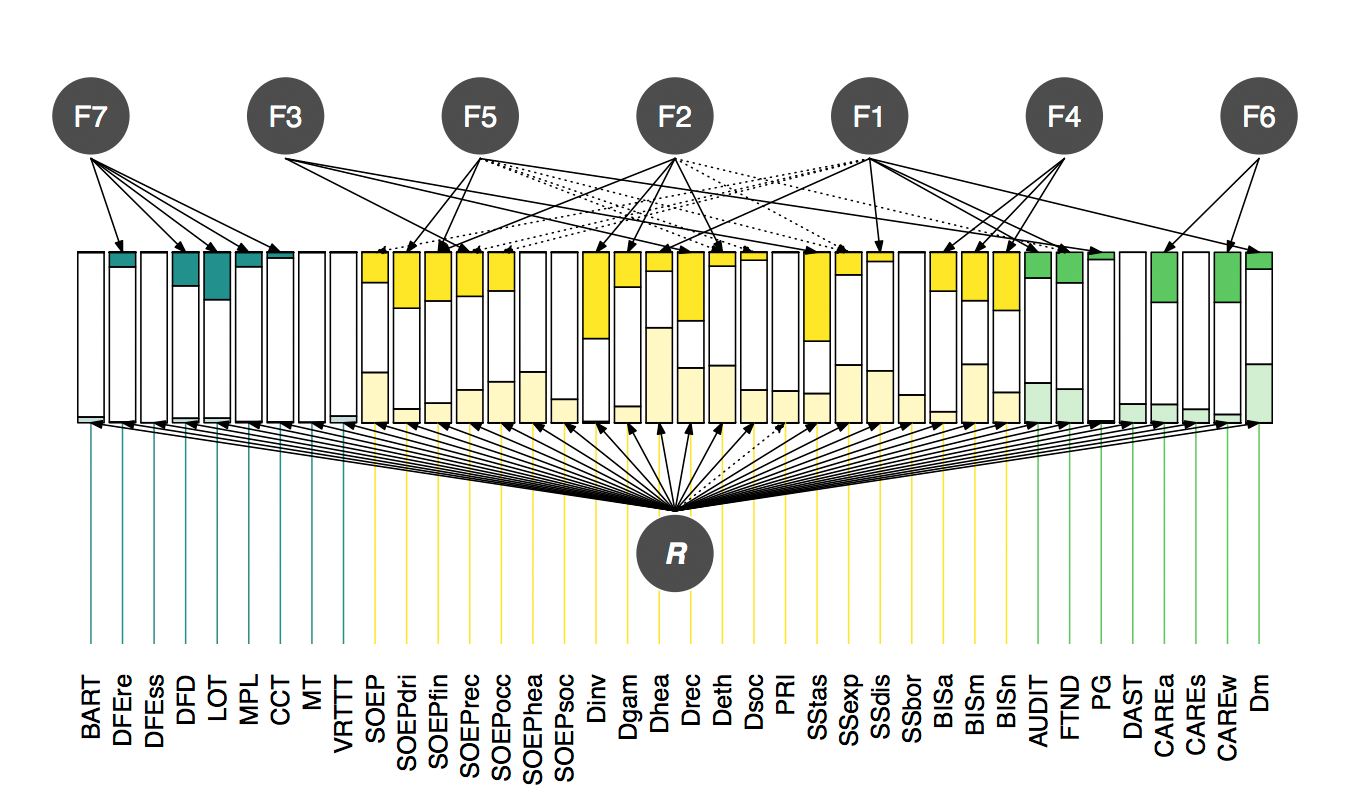
Bifactor model showing how much variance the general factor of risk preference (R) and the specific factors (F1-F7) explain in each of the different measures.
In a second paper, we exclusively focused on the behavioral measures (using the same dataset) and report follow-up analyses on the potential reasons underlying the observed inconcistencies between the behavioral elcitiation methods. However, extensive cognitive modeling analyses did not help to overcome the poor consistency of these tasks, and even on the level of model parameters this picture did not change. A potential reason for this "risk elicitation puzzle" is that people recruit different cognitive strategies in the different behavioral tasks.
In sum, our results offer a first step towards a general mapping of the construct risk preference, which encompasses both general and domain-specific components. In particular the observation of the general and stable factor may have important implications for future investigations of the biological foundations of risk preference (i.e., its genetic underpinnings and neural architecture). Moroever, these results have direct implications for the measurement of risk preference, both in the laboratory and "in the wild": Ideally, risk preference is assessed with multiple self-report measures, and our findings would advise against using most of the (incentivized) behavioral measures. Finally, should a comprehensive assessment not be feasible, some of the individual (self-report) measures may be used as proxies for R.
Key references:
Frey, R., Pedroni, A., Mata, R., Rieskamp, J., & Hertwig, R. (2017). Risk preference shares the psychometric structure of major psychological traits. Science Advances, 3, e1701381. doi:10.1126/sciadv.1701381 | PDF
Pedroni, A., Frey, R., Bruhin, A., Dutilh, G., Hertwig, R., & Rieskamp, J. (2017). The risk elicitation puzzle. Nature Human Behaviour, 1, 803-809. doi:10.1038/s41562-017-0219-x
Mata, R., Frey, R., Richter, D., Schupp, J., & Hertwig, R. (2018). Risk preference: A view from psychology. Journal of Economic Perspectives, 32, 155-172. doi:10.1257/jep.32.2.155 | PDF
Various psychological theories have put forth a series of candidate correlates of people's risk preference. Yet, the strength and robustness of their associations remain unclear because of disparate operationalizations of risk preference and analytic limitations in past research. Specifically, previous research testing the associations of variables such as sex, age, or cognitive ability has often i) implemented just one measure of risk preference (i.e., a particular self-report or behavioral measure), and ii) focused on few (if any) covariates and other, potentially competing predictor variables.
In this project, we were granted access to include a "risk module" in the Innovation Sample of the German Socioeconomic Panel (N = 916), where self-report data on people's risk preference is routinely collected. Our risk module consisted of two behavioral assessments of risk preference assessments. Taken together, the self-report measures, behavioral measures, as well as psychometric and statistical summary indices thereof, this resulted in a total of 17 operationalizations of risk preference. Moreover, we focused on 6 candidate correlates of risk preference and took into account up to 8 covariates in our analyses.
To assess the robustness of the main candidate correlates of risk preference, we implemented an exhaustive analytic approach called specification curve analysis (SCA; Simonsohn et al., 2015). The idea of SCA is to implement all possible model specifications (i.e., with all different dependent and independent variables) and to examine how strongly the effect of a candidate correlate varies – particularly as a function of which model specifications.

Illustration of specification curve analysis for the candidate correlate "household income".
Our results indicated that sex and age have robust and consistent associations with risk preference, whereas the other candidate correlates showed weaker and more (domain-) specific associations. For one candidate correlate (crystallized intelligence), there were no robust associations, at all. The results further demonstrate the important role of construct operationalization when assessing people's risk preferences: Self-reported propensity measures picked up various associations with the proposed correlates, but (incentivized) behavioral measures largely failed to do so.
We believe that this analytic approach provides some conclusive answers concerning which of several theoretically motivated candidate correlates show robust associations with risk preference. More generally, this method may prove useful for assessing associations between other constructs in the behavioral sciences, and ultimately may contribute to a more transparent and reproducible science.
Key references:
Frey, R., Richter, D., Schupp, J., Hertwig, R., & Mata, R. (2021). Identifying robust correlates of risk preference: A systematic approach using specification curve analysis. Journal of Personality and Social Psychology, 120, 538–557. doi:10.1037/pspp0000287 | PDF
Risk preference may shape everyday decision making and is assumed to be particularly expressed in maladaptive and clinical behaviors, such as impaired financial decision making, gambling, substance use, and taking excessive risks in recreational activities or regarding one's health. As individuals' risk preferences have the potential to influence the course of entire lives, with according consequences for society (e.g., in terms of pre- or intervention), the assessment of risk preference has been a focal research topic for decades.
However, whereas we have recently conducted comprehensive investigations on the nature of the construct risk preference and how to best measure it in the lab (see this tab), there is a surprising lack of scientific knowledge regarding the criteria (i.e., in terms of real-life outcomes) that the different measures of risk preference ought to predict. As such, the generalizability of risk preference remains poorly tested.
In the context of a four-year SNSF Ambizione project I am thus currently working on "unpacking" why particular measures of risk preference may work well (cf. Steiner, Seitz, & Frey, 2021) and whether other measures (i.e., particularly behavioral tasks) can potentially be improved in terms of representative design (cf. Steiner & Frey, 2021) – aimed at ultimately testing the generalizability of the construct of risk preference to relevant life outcomes.
Key references:
Steiner, M., Seitz, F., & Frey, R. (2021). Through the window of my mind: Mapping information integration and the cognitive representations underlying self-reported risk preference. Decision, 8, 97–122. doi:10.1037/dec0000127 | PDF
Steiner, M., & Frey, R. (2021). Representative design in psychological assessment: A case study using the Balloon Analogue Risk Task (BART). Journal of Experimental Psychology: General, 150, 2117-2136. doi:10.1037/xge0001036 | PDF
Millroth, P., & Frey, R. (2021). Fear and anxiety in the face of COVID-19: Negative dispositions towards risk and uncertainty as vulnerability factors. Journal of Anxiety Disorders, 83, 102454. doi:10.1016/j.janxdis.2021.102454 | PDF
Frey, R. (2021). Psychological drivers of individual differences in risk perception: A systematic case study focusing on 5G. Psychological Science, 32, 1592-1604. doi:10.1177/0956797621998312 | PDF
This project aims to contribute to a better understanding of how people navigate the modern world full of risk and uncertainty. Specifically, with increasing choice autonomy and a growing number of lifestyle options in the Global North, it is more and more in individuals' own hands to what extent they expose themselves to (life)-critical risks (e.g., risky behaviors that threaten physical and mental well-being). Moreover, although cultural, societal, and technological innovations have rendered several aspects of life safer than ever, such innovations almost by definition bring along novel risks and uncertainties (e.g., applications of artificial intelligence in medicine and other crucial domains of life).
Importantly, people do not approach these diverse risks and uncertainties in an absolutely static manner. For this reason this project not only examines how and why people differ (i.e., from person to person) in their risk perceptions and actual risk taking – but also studies how individual persons vary regarding their risk perceptions and risk taking across time and different situations.
Addressing this and related questions requires developing a comprehensive process model of risk taking. To this end, this project will establish a unifying theoretical framework and integrate process-level explanations that have been proposed by disparate theories of the behavioral sciences. Moreover, in developing and testing such a model, this project will make use of novel assessment technologies to also investigate risk taking in real-life contexts (e.g., by means of app-based measurements aimed at collecting continuous and situation-specific data) – rather than exclusively examining the psychological processes related to risk taking in the lab.
Ultimately, process-level explanations of individual differences in risk taking may be essential when it comes to designing novel choice architectures, preventions, and interventions. In addition, a more precise understanding of individual-level risk taking may also contribute to a better understanding of human behavior in the context of systemic risks (e.g., human-induced climate change, financial crises, political radicalization). In the latter, individual decision making scales up and causes ripple effects, and as such may not necessarily have immediate effects on individuals' own lives, but potentially dramatic consequences for society at large.
A special class of choices that I investigate are "decisions from experience": Specifically, in many of our decisions we start off with complete uncertainty about the potential outcomes of a decision, then gradually learn about these outcomes through exploration and information search, and eventually make a final choice based on our cognitive representatation of the choice environment. The following are examples of my work in this regard.
When exploring the possible outcomes of different choice options (e.g., sampling reviews on Tripadvisor when deciding between two hotels), the degree of pre-decisional search required to identify advantageous options hinges strongly on the statistical properties of the choice environments: In "kind" environments without any rare events, frugal search is sufficient to identify advantageous options. Conversely, in "wicked" environments with skewed outcome distributions, ample exploration is required to identify rare outcomes that may have large positive or negative consequences.
To what extent is people's pre-decisional search adaptive to different choice environments? And what if other people simultaneously pursue the same goal, giving rise to competitive pressure ("only one room left at this price")? In this project, I adopted an ecological perspective and systematically varied the statistical properties of different choice environments, in order to pit two theoretical perspectives on the role of competitive pressure against each other: An optimistic view assumes that competitive pressure triggers adaptive search and may thus lead to increased efficiency; conversely, a pessimistic view assumes that competitive pressure triggers agency-related concerns and may thus lead to minimal search across choice environments. The latter prediction implies that competitive pressure has a particularly negative effect on choice performance in wicked environments.

Search effort as a function of the experimental conditions (i.e., three different choice environments; two different search modes).
As the figure above illustrates, under competitive pressure pre-decisional search indeed tended to be minimal in all three choice environments – in line with the more pessimistic theoretical perspective. As a consequence, choice performance was particularly low in the (extremely) wicked environment. However, from the perspective of a cost-benefit framework that takes search costs into account (see figure below), competitive pressure may actually render search efficient in the kind and in the wicked environments.

Average-cost curves for each participant. Search is efficient if the empirical sample size is at the lowest point on each participant's idiosyncratic average-cost curve.
On a side note, in this project I was up for some exploration myself: In the spirit of trying out new avenues for promoting transparent and reproducible research, I was committed to publish this paper as a registered report (RR). The idea of this relatively new publication format is to run the paper's theoretical rationale through the full peer-review process at a scientific journal, with the goal of obtaining "in-principle acceptance" before the empirical studies are conducted. It was a very interesting but sometimes also difficult process, as it may be particularly hard to convince reviewers of the soundness and importance of the research questions a-priori, without being able to present fancy results yet. So I am glad that this paper found a nice home at JDM, and I hope that more psychological journals will adopt the format of RRs soon!
Key references:
Frey, R. (2020). Decisions from experience: Competitive search and choice in kind and wicked environments. Judgment and Decision Making, 15, 282-303. doi:10.1017/S1930297500007415 | PDF
In most decision-making situations across the entire life span, people typically do not enjoy access to summarized information about risky options. Instead, they may search for information and learn about environmental contingencies – thus making decisions from experience. Aging is associated with notable deficits in learning and memory – but do these translate into poorer decisions from experience? To address this question, we conducted three studies that used a sampling paradigm to investigate younger (M = 24 years) and older (M = 71 years) adults' decisions from experience.
In Study 1 participants made 12 decisions between pairs of payoff distributions in the lab. Study 2 implemented the same paradigm using portable devices, collecting 84 decisions per individual over a week. Study 3 extended the sampling paradigm by asking participants to make 12 decisions between two, four, and eight payoff distributions (in the lab). The figure below shows the implementation of the sampling paradigm on iPads (with two choice options per decision problem), as implemented in Study 2.
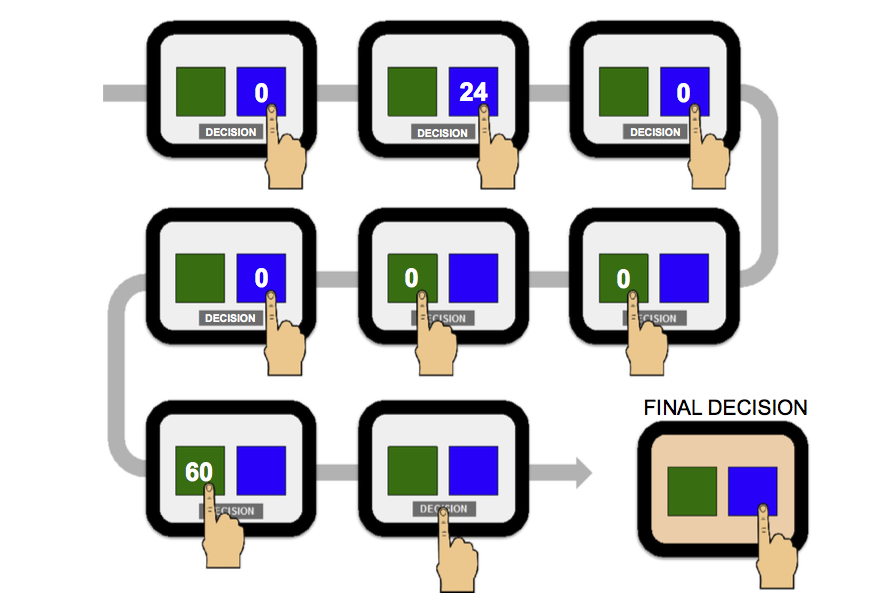
Sampling paradigm implemented on iPad, showing how a person explores two choice options and then makes a final decision.
Surprisingly, the behavioral results suggest that younger and older adults are relatively similar in how they search and what they choose when facing two payoff distributions (Studies 1 and 2). A computational modeling analysis on the level of individual participants showed that a simple delta-rule learning model best described the learning processes of most participants. That is, to the extent that ongoing updating processes (as described by the delta-rule learning model) unfold relatively automatically and effortlessly, older adults may be liberated from the detrimental consequences of cognitive aging in the case of decisions from experience with few decision options. However, with an increasing number of payoff distributions – either 2, 4, or 8 in Study 3 – age differences emerged. The figure below illustrates search effort as a function of the number of choice options in a decision problem.

Exploratory behavior of participants in Study 3, separately for younger and older adults, and as a function of whether choice set sizes were presented in increasing or decreasing order.
To what extent do cognitive abilities, in particular fluid intelligence, matter for search in decisions from eperience? As shown in the figure below, fluid intelligence was only weakly associated with search effort in conditions involving decisions between two options. However, the correlation between fluid intelligence and search was larger in conditions involving more than two options. This effect was even more pronounced for older adults in decision problems with a large choice set size.
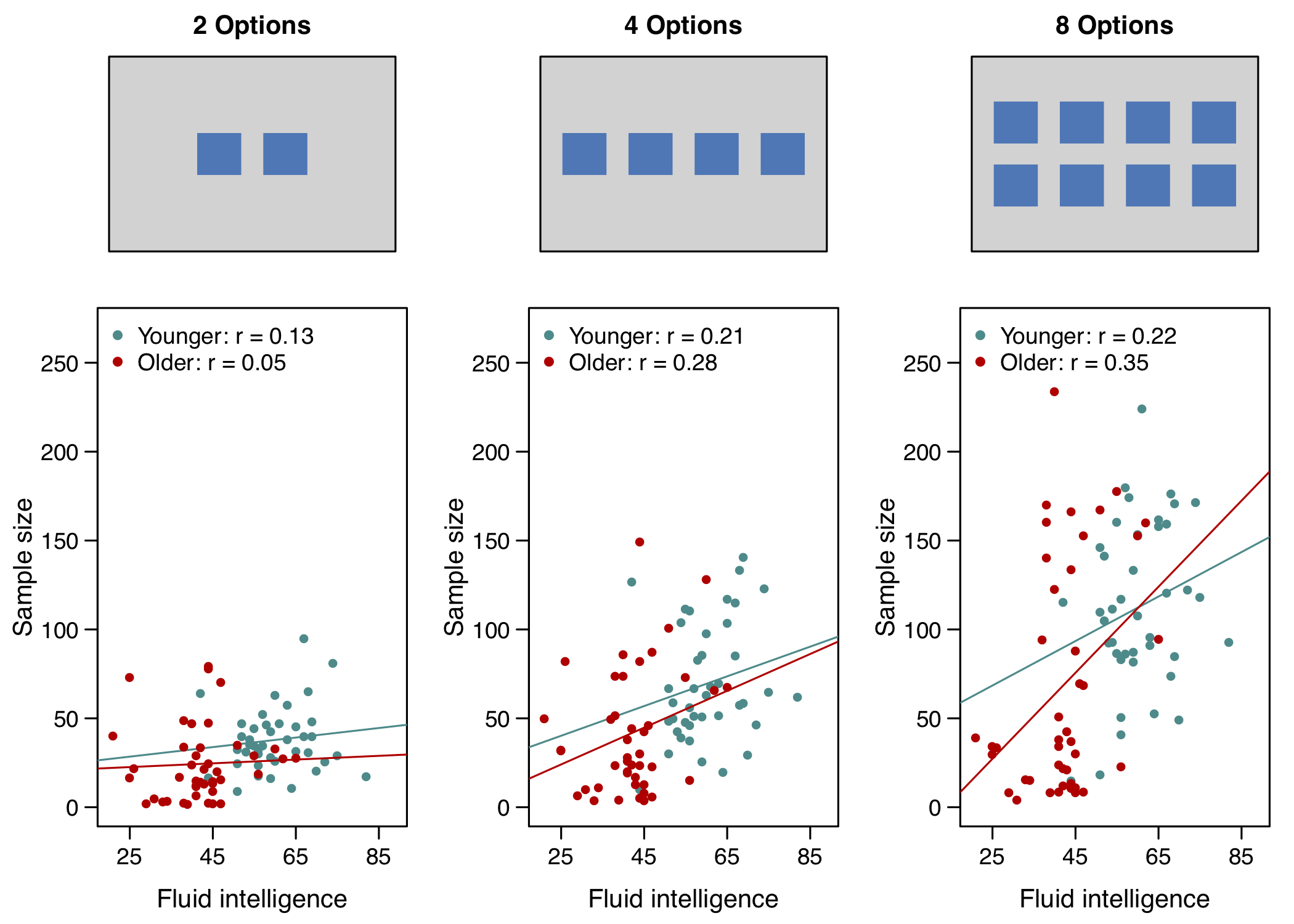
Relationship between fluid intelligence and search in the sampling paradigm, seperately for younger and older adults, and for different choice set sizes.
In sum, when people have to learn about decision options in real life, older adults may not necessarily perform worse than younger adults – despite substantial deficits in fluid cognitive abilities. Only when the choice environment is complex (e.g., when there are many decision options), reductions in exploratory behavior, and thus potentially also in choice performance, have to expected in older adults.
Key references:
Frey, R., Mata, R., & Hertwig, R. (2015). The role of cognitive abilities in decisions from experience: Age differences emerge as a function of choice set size. Cognition, 142, 60-80. doi:10.1016/j.cognition.2015.05.004
Mamerow, L., Frey, R., & Mata, R. (2016). Risk taking across the life span: A comparison of self-report and behavioral measures of risk taking. Psychology and Aging, 31, 711-723. doi:10.1037/pag0000124 | PDF
Before making decisions, people often need to explore their environment to learn about initially uncertain outcomes. To what extent does a person's emotional state shape exploration in such "decisions from experience"? Previously it has been suggested that fear regulates people's informational interface with the external world through its physiological expression (e.g., a more effective sampling of the visual field from widened eyes). In this project, we investigated whether the "emotional feeling" of fear triggers analogous changes in exploration, in terms of increased information sampling in decisions from experience – as suggested by appraisal tendency theories of emotions.
In a first study, we aimed to make use of naturally occurring emotional states and approached people in the waiting area of a comedy show and in the waiting room of a hospital's oral surgery department. The former participants turned out to be in a relatively happy default state (control group), whereas the latter reported being in a fearful state. We asked participants to complete a series of decisions from experience, which were implemented on iPads. In a second study, we induced different emotional states in a controlled lab experiment. The figure below shows the emotional states of participants in the lab study, as a function of the different experimental conditions, as well as pre- and post-study.

Participants' emotional states in the lab study (separately for the four conditions).
Our findings showed that fearful (relative to happy) people indeed explore decision environments substantially more before making a final choice. In the lab study, this increase was +61% (see figure below; findings for the field study were similar). The different degrees of exploration influenced participants' experience of rare events and, in turn, their final choices (i.e., an increased choice proportion of the options with higher expected values). That is, emotional states may be powerful factors in guiding people's exploratory behavior. Of course, when particular emotional states are misattributed to the wrong source or situation, their role may not necessarily be adaptive for information search and choice.

Participants' exploratory behavior in the lab study (separately for the four conditions).
Key references:
Frey, R., Hertwig, R., & Rieskamp, J. (2014). Fear shapes information acquisition in decisions from experience. Cognition, 132, 90-99. doi:10.1016/j.cognition.2014.03.009
Beyond my theoretical work on decision making under risk and uncertainty, I also strive to pursue projects in more applied settings, such as concerning decision making in the context of medicine and health, climate change, or new technologies.
What drives people's perceptions of novel risks, and how malleable are such risk perceptions? A better understanding of these questions is important as a strong polarization of people's risk perceptions may have far-reaching consequences, such as preventing informed debates about the advantages and disadvantages of novel technologies. This is particularly the case in the increasingly connected world, where extreme views are quickly disseminated and contribute to triggering filter bubbles (e.g., through social media).
This project aimed at providing an analytic framework that integrates multiple potential drivers of risk perception – as have been identified by previous psychological research – to thus gauge their relative influence in shaping inter- as well as intraindividual differences. To this end I focused on the latest generation of mobile communications technology, 5G.
Specifically, a multiverse analysis using a representative population sample in Switzerland indicated (see figure below) that interindividual differences in risk perceptions are strongly associated with hazard-related drivers (e.g., trust in the institutions regulating 5G, dread of 5G) as well as person-specific drivers (e.g., electromagnetic hypersensitivity). Crucially, interindividual differences in risk perceptions of 5G were strongly predictive of people's policy-related attitudes (e.g., voting intentions, need for more regulation). Moreover a field experiment based on a national expert report on 5G indicated that population-level effects are not readily triggered, yet identified links between intraindividual changes in psychological drivers and perceived risk. As such, these results highlight potential targets for future policy interventions, aimed at reconciling lay people's conflicting risk perceptions and facilitating (more) informed debates on the advantages and disadvantages of novel technologies in the future.

Key references:
Frey, R. (2021). Psychological drivers of individual differences in risk perception: A systematic case study focusing on 5G. Psychological Science, 32, 1592-1604. doi:10.1177/0956797621998312 | PDF
In this project we examined whether attitudes towards risk and uncertainty are predictive of people's responses and behaviors in a societal state of emergency, namely, the Covid-19 pandemic. Specifically, using a Bayesian multi-model inference analysis we examined the extent to which indidual dispositions in terms of "general risk aversion" and "intolerance of uncertainty" are pedictive of people's fear responses as measured by the fear of Covid-19 scale – over and beyond general anxiety levels as well as a series of other sociodemographic indicators.
As the figure below illustrates, general anxiety was the most important and strongest predictor of individual fear responses in the context of the Covid-19 pandemic. Yet, people's intolerance of uncertainty as well as their general risk aversion were also highly important and strong predictors in this respect, both as single predictors as well as in interaction with other variables.

In the paper we therefore discuss how the two constructs of general risk aversion and intolerance of uncertainty – both of which relatively widespread in the behavioral decision sciences – may be informative in clinical contexts, too. Specifically, our results suggest that these constructs may be instrumental to better understand mental-health problems arising from the Covid-19 pandemic, and may also be helpful during the development of novel treatment options.
Key references:
Millroth, P., & Frey, R. (2021). Fear and anxiety in the face of COVID-19: Negative dispositions towards risk and uncertainty as vulnerability factors. Journal of Anxiety Disorders, 83, 102454. doi:10.1016/j.janxdis.2021.102454 | PDF
In this paper we investigated whether formal institutions (e.g., governments, businesses, research institutions) may be able to send signals to influence the perception of social norms related to climate change – and whether people consequently also change their behavior. We did so using a randomized experiment with a sample of 3,627 American residents and used a multiverse approach (i.e., specification curve analysis) to examine the effects of our interventions on perceived social norms, behavioral intentions (e.g., carbon offsets), as well as actual donations to pro-environmental agencies.
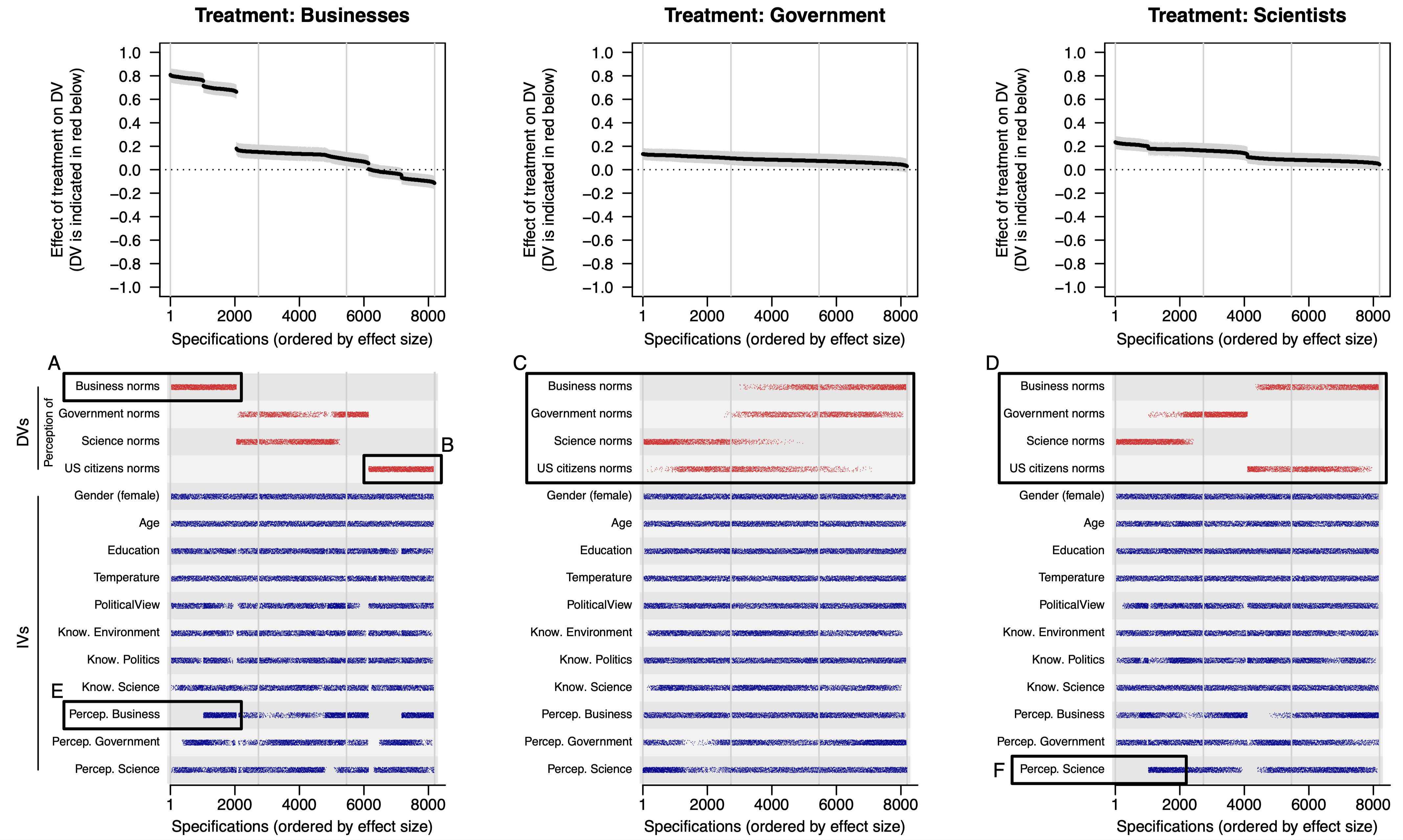
Specification curve analyses regarding the effects of different institutional signals on norm perceptions.
The specification curves shown in the figure above illustrate that different institutional signals trigger very nuanced patterns in terms of norm perceptions. For instance, a signal sent by a coalition of American businesses triggered a much stronger perception of the respective norms, whereas the signals sent by governments and research institutions managed to trigger somewhat more consistent yet overall much weaker norm perceptions. Furthermore, a second set of specification curve analyses indidcated that the signal sent from businesses tends to increase behavioral intentions and actual donations to non-governmental organizations committed to environmental and climate action, whereas the signals sent by governments and research institutions were only successful with respect to the former.
Overall, the implemented multiverse analysis illustrates under which conditions the messages from different institutional actors may or may not have effects on influencing norm perceptions and, by consequence, behavioral intentions and actual donations. As such these results may prove useful for future policy making in the context of climate change.
Key references:
Constantino, S. M., Pianta, S., Rinscheid, A., Frey, R., & Weber, E. U. (2021). The source is the message: The impact of institutional signals on climate change–related norm perceptions and behaviors. Climatic Change, 166, 1-20. doi:10.1007/s10584-021-03095-z | PDF
Various medical conditions can rob people of the ability to participate in decisions about their own treatment. In the United States, for instance, as many as 15,000 patients who live in a persistent vegetative state and another 100,000 who are minimally conscious cannot express their preferences in the event of life-threatening complications. Moreover, the dementia caused by Alzheimer’s disease – of which there are currently 47 million cases worldwide (rising to an estimated 131 million by 2050) – can deprive even fully conscious people of the power to make medical choices, as can severe brain injuries also in younger people (e.g., due to an accident). But how to best make surrogate decisions for incapacitated patients?
Previous research has focused on the accuracy of surrogate decisions (i.e., the proportion of correctly inferred preferences), and much less attention has been paid to the procedural preferences that patients' surrogates and patients have regarding specific approaches to making surrogate decisions. In fact, in one of our studies, in which we randomly assigned a "target person" in each of 64 families, with the remaining family members acting as potential surrogates tasked to infer the target person's treatment preferences in 24 medical scenarios, we found that different approaches to making surrogate decisions did not achieve substantial different accuracy levels (see figure below).
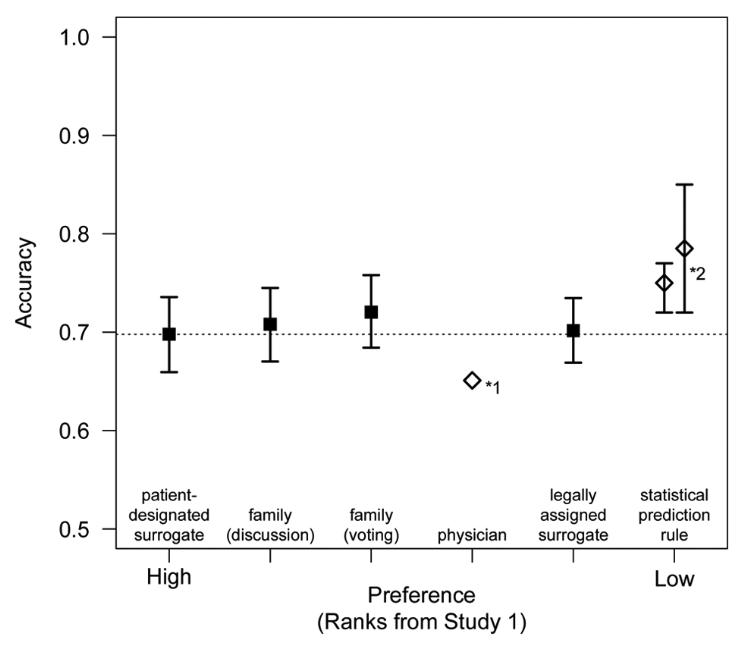
Accuracy of different approaches to making a surrogate decision.
Given that the differences in accuracy between the various approaches are virtually negligible, it is all the more important to have a solid empirical assessment of people's procedural preferences. The findings of our representative population surveys in Germany and Switzerland in this regard (see figure below) suggest marked differences across the various approaches.

Procedural preferences of potential surrogates and patients with different approaches to making a surrogate decision, separately for Germany and Switzerland (representative population surveys).
Specifically, the preferred approaches were a patient-designated surrogate and all family members making a collective decision by means of group discussion. The two least-preferred approaches were relying on a statistical prediction rule and delegating the decision to a physician. Although respondents taking the perspective of an incapacitated patient preferred a patient-designated surrogate, few people have designated such a surrogate in practice. Policy makers may thus consider implementing active choice. Moreover, potential patients and surrogates alike highly valued shared surrogate decisions among family members, suggesting that this possibility should be acknowledged explicitly in future legislation, and caregivers and physicians may consider promoting shared surrogate decisions in practice.
Key references:
Frey, R., Hertwig, R., & Herzog, S. M. (2014). Surrogate decision making: Do we have to trade off accuracy and procedural satisfaction? Medical Decision Making, 34, 258-69. doi:10.1177/0272989X12471729
Frey, R., Herzog, S. M., & Hertwig, R. (2018). Deciding on behalf of others: A population survey on procedural preferences for surrogate decision-making. BMJ Open, 8, e022289. doi:10.1136/bmjopen-2018-022289 | PDF